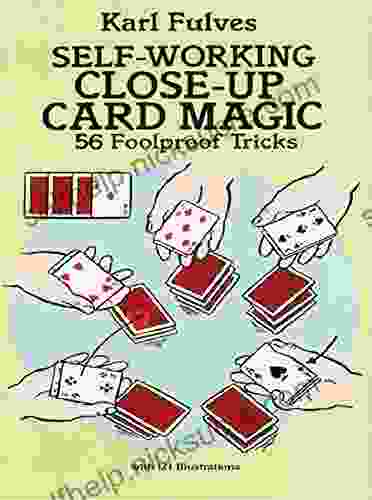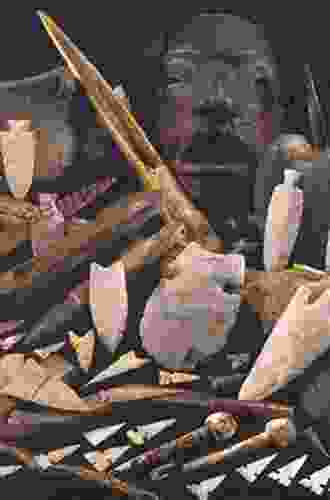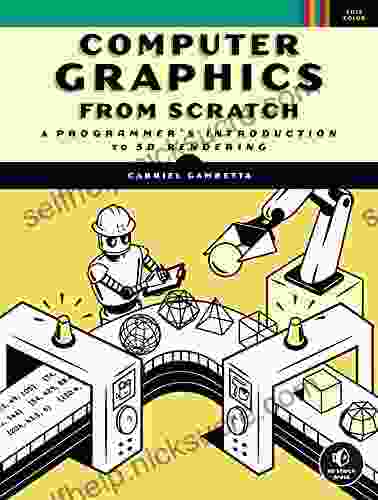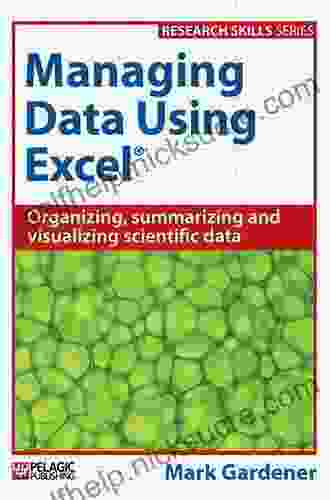A Comprehensive Introduction to 3D Rendering for Programmers: Unlocking the Power of Visual Computing

In the realm of computer science, 3D rendering stands as a cornerstone technology, enabling the creation of visually stunning and immersive experiences across a wide spectrum of applications. From captivating video games to realistic simulations and groundbreaking scientific visualizations, 3D rendering empowers programmers to bring their digital creations to life with unparalleled realism and depth.
4.4 out of 5
| Language | : | English |
| File size | : | 13521 KB |
| Text-to-Speech | : | Enabled |
| Screen Reader | : | Supported |
| Enhanced typesetting | : | Enabled |
| Print length | : | 325 pages |
For programmers venturing into the world of 3D rendering, this article serves as a comprehensive guide, meticulously crafted to provide an in-depth understanding of the fundamental concepts, techniques, and applications that underpin this field. Through a comprehensive exploration of the intricacies of 3D modeling, lighting, shading, texturing, and animation, we aim to equip programmers with the knowledge and skills necessary to embark on a successful journey in the realm of visual computing.
1. Fundamentals of 3D Rendering
At the heart of 3D rendering lies a fundamental concept known as the 3D model. A 3D model encapsulates the geometric representation of an object, defining its shape, size, and proportions. Programmers often leverage 3D modeling software to construct these models, either by manually sculpting them or by importing predefined assets from libraries.
Once a 3D model is in place, the next crucial step involves applying materials to its surface. Materials govern the visual properties of an object, such as its color, texture, and reflectivity. By meticulously assigning materials to different parts of the model, programmers can achieve a remarkable level of visual realism.
2. Illumination and Lighting
Lighting plays a pivotal role in 3D rendering, as it brings models to life by simulating the interaction of light with their surfaces. Programmers can strategically position virtual light sources within their scenes to achieve specific lighting effects, such as creating dramatic shadows, enhancing depth, or highlighting key elements.
Understanding the principles of lighting is essential for programmers to master the art of crafting realistic and visually appealing 3D environments. This involves delving into concepts such as ambient light, directional light, and spotlights, each of which contributes to the overall illumination of the scene.
3. Shading and Texturing
Shading techniques empower programmers to define how surfaces react to light, creating subtle variations in color and intensity. By employing sophisticated algorithms, programmers can simulate complex physical phenomena such as diffuse reflection, specular highlights, and subsurface scattering, resulting in stunningly realistic materials.
Texturing further enhances the visual fidelity of 3D models by adding detailed surface patterns and textures. Programmers can seamlessly apply textures to models, allowing them to replicate real-world materials such as wood, metal, and fabric with remarkable accuracy.
4. Animation and Motion
The realm of 3D rendering extends beyond static scenes to encompass the captivating world of animation. Programmers can breathe life into their creations by defining keyframes and interpolating between them, creating smooth and fluid motion sequences.
Animation techniques encompass a wide range of possibilities, from simple object transformations to complex character rigs and physics simulations. Programmers can leverage specialized software and libraries to effortlessly create dynamic and engaging animations.
5. Applications of 3D Rendering
The applications of 3D rendering span a vast and ever-expanding landscape, stretching across diverse industries and disciplines. Some prominent examples include:
a. Video Games
3D rendering is the cornerstone of modern video games, powering the stunning graphics and immersive environments that captivate players worldwide. Programmers leverage advanced rendering techniques to create visually compelling experiences, ranging from sprawling open-world adventures to fast-paced competitive shooters.
b. Film and Animation
The film and animation industry relies heavily on 3D rendering to bring imaginative characters and worlds to life. Programmers collaborate with artists and animators to create breathtaking cinematic experiences, from blockbuster movies to heartwarming animated features.
c. Architecture and Design
3D rendering has revolutionized the architecture and design industries, enabling professionals to visualize and plan their projects with unprecedented precision. Programmers develop specialized software that allows architects and designers to create detailed 3D models of buildings, interiors, and landscapes, facilitating informed decision-making and seamless collaboration.
d. Medical Imaging and Visualization
In the field of medicine, 3D rendering plays a vital role in medical imaging and visualization. Programmers develop software that transforms complex medical data into interactive 3D models, empowering doctors and researchers to gain deeper insights into patient anatomy and treatment options.
e. Scientific Visualization
3D rendering serves as an indispensable tool for scientific visualization, enabling researchers to explore and communicate complex scientific data. Programmers collaborate with scientists to create immersive 3D representations of data, facilitating groundbreaking discoveries and advancements in various scientific disciplines.
The world of 3D rendering offers programmers a thrilling canvas upon which to unleash their creativity and innovation. By mastering the fundamental concepts and techniques outlined in this article, programmers can unlock the power of visual computing, crafting captivating and immersive experiences that span a multitude of applications. From video games and films to architecture, medicine, and scientific visualization, the possibilities are limitless for those who embrace the art of 3D rendering.
As technology continues to advance, new and groundbreaking developments in 3D rendering are constantly emerging. Programmers who stay abreast of these advancements will be at the forefront of innovation, pushing the boundaries of visual computing and shaping the future of digital experiences.
4.4 out of 5
| Language | : | English |
| File size | : | 13521 KB |
| Text-to-Speech | : | Enabled |
| Screen Reader | : | Supported |
| Enhanced typesetting | : | Enabled |
| Print length | : | 325 pages |
Do you want to contribute by writing guest posts on this blog?
Please contact us and send us a resume of previous articles that you have written.
 Fiction
Fiction Non Fiction
Non Fiction Romance
Romance Mystery
Mystery Thriller
Thriller SciFi
SciFi Fantasy
Fantasy Horror
Horror Biography
Biography Selfhelp
Selfhelp Business
Business History
History Classics
Classics Poetry
Poetry Childrens
Childrens Young Adult
Young Adult Educational
Educational Cooking
Cooking Travel
Travel Lifestyle
Lifestyle Spirituality
Spirituality Health
Health Fitness
Fitness Technology
Technology Science
Science Arts
Arts Crafts
Crafts DIY
DIY Gardening
Gardening Petcare
Petcare R F Egerton
R F Egerton B F Skinner
B F Skinner Scott Turansky
Scott Turansky Uta C Merzbach
Uta C Merzbach Tiffany Wasson
Tiffany Wasson Laurie Kennedy Malone
Laurie Kennedy Malone Hilary Scarlett
Hilary Scarlett Peter Levin
Peter Levin Harlan Coben
Harlan Coben Greg Lavern
Greg Lavern Lore M Dickey
Lore M Dickey George J Hademenos
George J Hademenos Ayn Rand
Ayn Rand John Austin
John Austin Sandy Hall
Sandy Hall Greg B Smith
Greg B Smith Justine Kerfoot
Justine Kerfoot Richard Ferber
Richard Ferber Alan Vermilye
Alan Vermilye G R S Mead
G R S Mead Ori Hofmekler
Ori Hofmekler Ethan Gallogly
Ethan Gallogly Blake Boles
Blake Boles Brian Christian
Brian Christian Kathleen M Eisenhardt
Kathleen M Eisenhardt Stephanie Donaldson Pressman
Stephanie Donaldson Pressman Simon Askey
Simon Askey Kevin Kelly
Kevin Kelly Jerry Scott
Jerry Scott N West Moss
N West Moss Karen Whitley Bell
Karen Whitley Bell Jayme Adelson Goldstein
Jayme Adelson Goldstein Beverly Conyers
Beverly Conyers Yang Jwing Ming
Yang Jwing Ming Casey Barber
Casey Barber Robert M Bramson
Robert M Bramson Jeff Szuhay
Jeff Szuhay Hugh Acheson
Hugh Acheson David Landis
David Landis Esther M Toddler
Esther M Toddler Autumn Carpenter
Autumn Carpenter Barbara Oakley Phd
Barbara Oakley Phd Brett Ortler
Brett Ortler Sam Pathy
Sam Pathy Seth Kantner
Seth Kantner Robert W Sullivan Iv
Robert W Sullivan Iv John Littleford
John Littleford Vb Leghorn
Vb Leghorn Gary Webster
Gary Webster David Acheson
David Acheson Tara Sim
Tara Sim S Ali Myers
S Ali Myers Dory Willer
Dory Willer Martin Rees
Martin Rees Martins Zaumanis
Martins Zaumanis Bruno Barnhart
Bruno Barnhart Lindsey Philpott
Lindsey Philpott Matt Wallaert
Matt Wallaert Katie Hoff
Katie Hoff Deanna Roy
Deanna Roy John S Ahlquist
John S Ahlquist Jessica S Olson
Jessica S Olson Deborah Hughes Hallett
Deborah Hughes Hallett Drew Harris
Drew Harris Jacqui Letran
Jacqui Letran Steven Rinella
Steven Rinella Norman Ollestad
Norman Ollestad Liz Carmack
Liz Carmack Robert E Howard
Robert E Howard Inga Aksamit
Inga Aksamit Picabo Street
Picabo Street Marie Rutkoski
Marie Rutkoski Bob Weeks
Bob Weeks Hourly History
Hourly History Paul Pilkington
Paul Pilkington Proprietary Edition Kindle Edition
Proprietary Edition Kindle Edition Sadie Keller
Sadie Keller Smadar Lavie
Smadar Lavie Kathy Hirsh Pasek
Kathy Hirsh Pasek Ellyn Sanna
Ellyn Sanna Ron Dalby
Ron Dalby Rajeev Lal
Rajeev Lal Fred Provenza
Fred Provenza Mercedes Lackey
Mercedes Lackey Rudy Sanchez
Rudy Sanchez Laura A Roser
Laura A Roser William M Kelso
William M Kelso Simon Pridmore
Simon Pridmore Babatunde Peter
Babatunde Peter Don Orwell
Don Orwell Siddhartha Mukherjee
Siddhartha Mukherjee Pete Whittaker
Pete Whittaker Paul Tukey
Paul Tukey Patricia Stacey
Patricia Stacey Rick Burgess
Rick Burgess Ed Jaworowski
Ed Jaworowski Leslie T Chang
Leslie T Chang Chris Santella
Chris Santella Tom Humphries
Tom Humphries Rachel Mitchell
Rachel Mitchell Aylette Jenness
Aylette Jenness Gaby Melian
Gaby Melian Steve Colgate
Steve Colgate Kimberly Willis
Kimberly Willis Eitan Bar
Eitan Bar Hillary Davis
Hillary Davis John Connor
John Connor Suzanne Jurmain
Suzanne Jurmain Joe Ryder
Joe Ryder Lara Lillibridge
Lara Lillibridge Tracy Deonn
Tracy Deonn Jessica Nabongo
Jessica Nabongo Elizabeth M Ward
Elizabeth M Ward Laurie Katz
Laurie Katz Emily Whaley
Emily Whaley M D William W Forgey
M D William W Forgey Renzo Gracie
Renzo Gracie Paul Oliver
Paul Oliver Reinhard Bonnke
Reinhard Bonnke Lois Lowry
Lois Lowry David Dalglish
David Dalglish Linda Dobson
Linda Dobson Ashley Rhodes Courter
Ashley Rhodes Courter Lamis Chebbi
Lamis Chebbi Spike Walker
Spike Walker Karen Skerrett
Karen Skerrett Lawrence A Kane
Lawrence A Kane Nsca National Strength Conditioning Association
Nsca National Strength Conditioning Association Conrad Goeringer
Conrad Goeringer Rufus Stephens
Rufus Stephens Rehan Haider
Rehan Haider Nic Stone
Nic Stone Brent Runyon
Brent Runyon James Deetz
James Deetz Todd Mikkelsen
Todd Mikkelsen Gillian Bradshaw
Gillian Bradshaw Family Traditions Publishing
Family Traditions Publishing David J Miklowitz
David J Miklowitz Staff Of The Harvard Crimson
Staff Of The Harvard Crimson Mohamed F El Hewie
Mohamed F El Hewie Stan Fischler
Stan Fischler Dustin Hansen
Dustin Hansen Jennifer Love
Jennifer Love Graham Frankel
Graham Frankel Avery Faigenbaum
Avery Faigenbaum Don J Sharpsteen
Don J Sharpsteen Colin Towell
Colin Towell Jim Fay
Jim Fay Mia Baxter
Mia Baxter Gabriel Gambetta
Gabriel Gambetta Patty Hahne
Patty Hahne Patrick Hamill
Patrick Hamill Aspen Matis
Aspen Matis Kilian Jornet
Kilian Jornet Fred Alan Wolf
Fred Alan Wolf Robert Warden
Robert Warden Charles L Thompson
Charles L Thompson Dima Zales
Dima Zales Jonothan Page
Jonothan Page Mami Wata
Mami Wata Lew Freedman
Lew Freedman Larry Gonick
Larry Gonick Catherine Rodgers
Catherine Rodgers Richard Strozzi Heckler
Richard Strozzi Heckler Martha Raile Alligood
Martha Raile Alligood Andy Mcilree
Andy Mcilree Zhi Gang Sha
Zhi Gang Sha Daffodil Campbell
Daffodil Campbell Blake Dresden
Blake Dresden Gerald Paul Clifford
Gerald Paul Clifford Kathy Pike
Kathy Pike Kevin Bales
Kevin Bales Roger Lajoie
Roger Lajoie Tom Rea
Tom Rea John Gierach
John Gierach Gary D Wale
Gary D Wale Terry Marsh
Terry Marsh Deborah Miller
Deborah Miller Terasa Cooley
Terasa Cooley Bill Thorness
Bill Thorness Peter Gieler
Peter Gieler Martin Liebscher
Martin Liebscher Florin Grancea
Florin Grancea Fran Zimniuch
Fran Zimniuch Dusty Phillips
Dusty Phillips Jim Holt
Jim Holt Carly Gelsinger
Carly Gelsinger Levison Wood
Levison Wood John Misha Petkevich
John Misha Petkevich Larry Hart
Larry Hart Audre Lorde
Audre Lorde Larry Dane Brimner
Larry Dane Brimner Qukids
Qukids Robert Simons
Robert Simons George Orwell
George Orwell Kira Breed Wrisley
Kira Breed Wrisley Audrey Coulthurst
Audrey Coulthurst T J Emerson
T J Emerson Foster Provost
Foster Provost Catherine Belknap
Catherine Belknap Paul Parsons
Paul Parsons Bernd Brunner
Bernd Brunner Aubrey Hargis
Aubrey Hargis Lisa Gache
Lisa Gache Samantha Bongeka Nqoko
Samantha Bongeka Nqoko Randi Kreger
Randi Kreger Aubre Andrus
Aubre Andrus Eric Jones
Eric Jones James Ladyman
James Ladyman Laura Riley
Laura Riley Ken Phillips
Ken Phillips Yogi Ramacharaka
Yogi Ramacharaka Asia Citro
Asia Citro C M Gray
C M Gray Babu The Panda
Babu The Panda Christine Ann Lawson
Christine Ann Lawson Sharon Slater
Sharon Slater William Woys Weaver
William Woys Weaver Jim Collins
Jim Collins Steve Bisheff
Steve Bisheff Chloe Lukasiak
Chloe Lukasiak Bernie Chowdhury
Bernie Chowdhury Dave Ramsey
Dave Ramsey Audrey Grey
Audrey Grey Edward Lee
Edward Lee John Quick
John Quick Gemma Mccrae
Gemma Mccrae The Car Crash Detective
The Car Crash Detective Richard Miles
Richard Miles Vance Packard
Vance Packard Lisa Fain
Lisa Fain Larry Olmsted
Larry Olmsted Fennel Hudson
Fennel Hudson Moon Travel Guides
Moon Travel Guides Patrick Holford
Patrick Holford Gabrielle Bossis
Gabrielle Bossis David Shoalts
David Shoalts Ernestine Gilbreth Carey
Ernestine Gilbreth Carey Nfhs
Nfhs Nathan Clark
Nathan Clark Audrey Sutherland
Audrey Sutherland Wilfrid Jonson
Wilfrid Jonson Print Replica Kindle Edition
Print Replica Kindle Edition Eric S Raymond
Eric S Raymond Penny Simkin
Penny Simkin Conrad Anker
Conrad Anker Jessica Nordell
Jessica Nordell Greta Eskridge
Greta Eskridge Spanked Teen
Spanked Teen Heather E Schwartz
Heather E Schwartz Linda Fairley
Linda Fairley Deborah T Goldberg
Deborah T Goldberg Lyn Millner
Lyn Millner Maya Angelou
Maya Angelou Colleen Hoover
Colleen Hoover Izabelle Winter
Izabelle Winter John Sharp
John Sharp Brandon Sneed
Brandon Sneed Dk Eyewitness
Dk Eyewitness Deanna Pecaski Mclennan
Deanna Pecaski Mclennan John Skinner
John Skinner Kjell Erik Rudestam
Kjell Erik Rudestam Jesus Salcedo
Jesus Salcedo Tarik Unal
Tarik Unal Dana Wechsler Linden
Dana Wechsler Linden Nancy Friday
Nancy Friday John Gray
John Gray Peggy Kaye
Peggy Kaye Beatrice Bruteau
Beatrice Bruteau Joe Friel
Joe Friel E Paul Zehr
E Paul Zehr Leigh Pearson
Leigh Pearson Kay Wills Wyma
Kay Wills Wyma Temple Bailey
Temple Bailey Claire Nance
Claire Nance Tara Dixon Engel
Tara Dixon Engel Dr Jerisa Berry
Dr Jerisa Berry Mark Gardener
Mark Gardener Steve Oakes
Steve Oakes James Nestor
James Nestor Peter Bronski
Peter Bronski Nick Fragel
Nick Fragel Mark Baker
Mark Baker Jessica Seinfeld
Jessica Seinfeld Collins Dictionaries
Collins Dictionaries Leonard Mlodinow
Leonard Mlodinow Sanya Richards Ross
Sanya Richards Ross John Swinton
John Swinton Dougald Macdonald
Dougald Macdonald Charles D Garvin
Charles D Garvin Brigid Kemmerer
Brigid Kemmerer Sara Zarr
Sara Zarr Shelly Rainforth Collins
Shelly Rainforth Collins David Code
David Code Don Casey
Don Casey J C Pater
J C Pater Jeffrey Freed
Jeffrey Freed Jerome D Smalls
Jerome D Smalls Timo Holmquist
Timo Holmquist Tony Nester
Tony Nester Maria Montessori
Maria Montessori Deborah J Rumsey
Deborah J Rumsey Barbara Blitzer
Barbara Blitzer Jens Voigt
Jens Voigt Brian A Hall
Brian A Hall Ryan Sleeper
Ryan Sleeper Thane K Pratt
Thane K Pratt Timothy J Jorgensen
Timothy J Jorgensen Kindle Edition
Kindle Edition Mark Coeckelbergh
Mark Coeckelbergh Mike Kim
Mike Kim Jermaine Marshall
Jermaine Marshall R Scott Thornton
R Scott Thornton Cora Seton
Cora Seton Lucy Hopping
Lucy Hopping E Randolph Richards
E Randolph Richards Efrain Galeano
Efrain Galeano Gareth Loy
Gareth Loy Cat Coluccio
Cat Coluccio Mike Doyle
Mike Doyle Huw Price
Huw Price Dean Karnazes
Dean Karnazes Joe Baird
Joe Baird Madeleine Roux
Madeleine Roux Richard Boergers
Richard Boergers Bubba Watson
Bubba Watson Lise Eliot
Lise Eliot Tracey L Moore
Tracey L Moore Ken Fry
Ken Fry Athena P Kourtis
Athena P Kourtis Kaleb Dahlgren
Kaleb Dahlgren Richard H Immerman
Richard H Immerman Michael Paul
Michael Paul Brooke Dojny
Brooke Dojny Belinda Smith Sullivan
Belinda Smith Sullivan Adam Parkinson
Adam Parkinson Mandy Khoshnevisan
Mandy Khoshnevisan Keith Mcnulty
Keith Mcnulty Carolyn Wyman
Carolyn Wyman Marc Kery
Marc Kery Janet Gurtler
Janet Gurtler Carol Ann Rinzler
Carol Ann Rinzler Maureen Connolly
Maureen Connolly Joe Hutto
Joe Hutto Arthur Benjamin
Arthur Benjamin Asiphile Qulu
Asiphile Qulu Tim Muehlhoff
Tim Muehlhoff Beverly Bell
Beverly Bell Vasily Mahanenko
Vasily Mahanenko Warren W Wiersbe
Warren W Wiersbe Lilith Dorsey
Lilith Dorsey T Berry Brazelton
T Berry Brazelton Jonathan Cane
Jonathan Cane Brent Dykes
Brent Dykes Gabriela Rosa
Gabriela Rosa Shepherd Mead
Shepherd Mead Mary Jayne Baker
Mary Jayne Baker Karen Berger
Karen Berger Atlas Kane
Atlas Kane Stewart M Green
Stewart M Green Cornelia Pelzer Elwood
Cornelia Pelzer Elwood Quick Reads
Quick Reads Pat Mora
Pat Mora Susan M Sheridan
Susan M Sheridan Morgan Murphy
Morgan Murphy Dan Blanchard
Dan Blanchard Shelley Johnson
Shelley Johnson Heather Heying
Heather Heying Robert M Steward
Robert M Steward Philip Clayton
Philip Clayton Luca Caioli
Luca Caioli Avinash K Dixit
Avinash K Dixit Judith Z Kallenbach
Judith Z Kallenbach Kathy Jackson
Kathy Jackson Miriam Erick
Miriam Erick Darren Palmer
Darren Palmer E W Bullinger
E W Bullinger Lori Foster
Lori Foster Michael Grimm
Michael Grimm Sarah B Bush
Sarah B Bush Dan Morse
Dan Morse Madelynne Diness Sheehan
Madelynne Diness Sheehan John D Mccann
John D Mccann Prayer M Madueke
Prayer M Madueke Paul Bodine
Paul Bodine Duncan J Watts
Duncan J Watts John Updike
John Updike Johny Pitts
Johny Pitts Nita Sweeney
Nita Sweeney Eunice Pennington
Eunice Pennington Patrisia Gonzales
Patrisia Gonzales Jeff Vandermeer
Jeff Vandermeer Daria Blackwell
Daria Blackwell Sharon Baranoski
Sharon Baranoski Harry Bauld
Harry Bauld Carol Potter
Carol Potter Johnette Howard
Johnette Howard Ethan Sawyer
Ethan Sawyer Lizzie Lane
Lizzie Lane Sofia Price
Sofia Price Sonia Mainstone Cotton
Sonia Mainstone Cotton Nancy Owens Barnes
Nancy Owens Barnes Steven M Bragg
Steven M Bragg Rena Ejiogu
Rena Ejiogu Fred Mitchell
Fred Mitchell Linda Wong
Linda Wong Augustus M Walton
Augustus M Walton Susan F Paterno
Susan F Paterno Marc D Lewis
Marc D Lewis Conor Sullivan
Conor Sullivan James Garbarino
James Garbarino Loren W Christensen
Loren W Christensen Darja Wagner Ph D
Darja Wagner Ph D Austa Somvichian Clausen
Austa Somvichian Clausen Bob Smale
Bob Smale Emenwa Global
Emenwa Global Sarah Boslaugh
Sarah Boslaugh Ben Riggs
Ben Riggs M Prefontaine
M Prefontaine Clive Finlayson
Clive Finlayson Alan Lightman
Alan Lightman Kay Harris Kriegsman
Kay Harris Kriegsman Antoni Porowski
Antoni Porowski Mike Eruzione
Mike Eruzione Bradley Stone
Bradley Stone Tori Bortman
Tori Bortman Leonard Susskind
Leonard Susskind Ken Denmead
Ken Denmead Cynthia Hand
Cynthia Hand Casey Schreiner
Casey Schreiner Geoffrey Budworth
Geoffrey Budworth Deborah Falaye
Deborah Falaye Karl Fulves
Karl Fulves Julia Albu
Julia Albu Joe Kelsey
Joe Kelsey Scott Mactavish
Scott Mactavish Robert Chuckrow
Robert Chuckrow Augustine Wetta
Augustine Wetta Katie Cotugno
Katie Cotugno Vicki Hoefle
Vicki Hoefle Patricia L Thompson
Patricia L Thompson Ayesha Ratnayake
Ayesha Ratnayake Tomasz Witkowski
Tomasz Witkowski Austin Ruse
Austin Ruse Matt Forbeck
Matt Forbeck Danny Staple
Danny Staple Chris Burkard
Chris Burkard Roy Benaroch Md
Roy Benaroch Md Pedro G Ferreira
Pedro G Ferreira Mike Mastracci
Mike Mastracci Robert T Clemen
Robert T Clemen Greg Gatz
Greg Gatz Ben Sasse
Ben Sasse Debora Rasio
Debora Rasio Larry Miller
Larry Miller Kristin Fontichiaro
Kristin Fontichiaro Vivian Sandau
Vivian Sandau Jeannie Burlowski
Jeannie Burlowski Darryl Cunningham
Darryl Cunningham Joanne Simon Walters
Joanne Simon Walters John Hiker
John Hiker Christopher Burris
Christopher Burris Linda West
Linda West Dk
Dk Ervin Laszlo
Ervin Laszlo William Schoolcraft
William Schoolcraft Mark Parman
Mark Parman Tony Clunn
Tony Clunn Denny Emerson
Denny Emerson James Feess
James Feess Gail M Nelson
Gail M Nelson Nina W Brown
Nina W Brown Steven Brill
Steven Brill Cece Winans
Cece Winans Janis B Meredith
Janis B Meredith Kenneth P Miller
Kenneth P Miller Sam Quek
Sam Quek Stephen Morris
Stephen Morris J A Baker
J A Baker James Ori
James Ori Samir Okasha
Samir Okasha Barry Cunliffe
Barry Cunliffe Manly P Hall
Manly P Hall Carl Safina
Carl Safina Miriam Manela
Miriam Manela
Light bulbAdvertise smarter! Our strategic ad space ensures maximum exposure. Reserve your spot today!

 Timothy WardThe 101 Most Important Questions Answered By Homeschooling's Most Respected...
Timothy WardThe 101 Most Important Questions Answered By Homeschooling's Most Respected...
 Danny SimmonsUnlocking the Mind-Body Connection for Enhanced Fertility, Stress Reduction,...
Danny SimmonsUnlocking the Mind-Body Connection for Enhanced Fertility, Stress Reduction,... Arthur MasonFollow ·19.2k
Arthur MasonFollow ·19.2k Leslie CarterFollow ·19.5k
Leslie CarterFollow ·19.5k Timothy WardFollow ·14.8k
Timothy WardFollow ·14.8k Jermaine PowellFollow ·18.7k
Jermaine PowellFollow ·18.7k Gustavo CoxFollow ·3.3k
Gustavo CoxFollow ·3.3k Quentin PowellFollow ·10.9k
Quentin PowellFollow ·10.9k Oscar BellFollow ·5.4k
Oscar BellFollow ·5.4k Herman MelvilleFollow ·12.2k
Herman MelvilleFollow ·12.2k

 Jett Powell
Jett PowellHow to Choose a Church That's Right for You
Choosing a church...

 Bryan Gray
Bryan GrayThe Unbelievable World of Self-Working Close Up Card...
Imagine having...

 Junot Díaz
Junot DíazUnveiling the Enchanting Old City Laneways and Diavatika:...
Crete, the largest of...

 Jamison Cox
Jamison CoxA Year in the American Wild: Recreating a Feast from...
For one year, I lived off...

 Holden Bell
Holden BellArchaeology of Early American Life: An Exploration of...
The archaeology...

 Rodney Parker
Rodney ParkerRegain Your Fertility By Reversing Insulin Resistance,...
If you're struggling to conceive, you may be...
4.4 out of 5
| Language | : | English |
| File size | : | 13521 KB |
| Text-to-Speech | : | Enabled |
| Screen Reader | : | Supported |
| Enhanced typesetting | : | Enabled |
| Print length | : | 325 pages |








